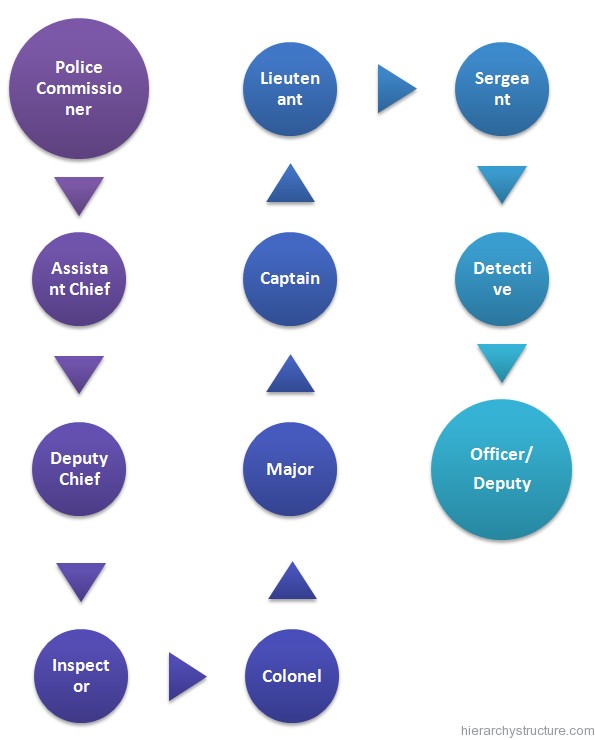The American Police system is divided into various types of agencies such as federal law enforcement agencies, state police departments, sheriff’s departments, municipal police and special police agencies like transit police and school police. The various major law enforcement agencies are Federal Bureau of Investigation (FBI), Bureau of Alcohol, Tobacco and Firearms (ATF), Drug Enforcement Administration (DEA), The U.S Marshals Service, The Secret Service, The Immigration and Naturalization Service (INS). The American Police Hierarchy varies along the various federal, state, local and sheriff’s police departments. However, there is a generalized organizational structure of the police ranks, which we are going to discuss in the following paragraphs.
We will discuss the American Police Hierarchy in details specifying the various ranks and the specific job roles undertaken by each and every rank in the decreasing order of ranks.

Police Commissioner/Chief of Police/Superintendent: The Chief of Police is the top official in the chain of command of a police department. The alternative titles used for this position are Commissioner, Chief Constable, and Superintendent etc. In the large metropolitan departments, the title Police Commissioner is used. In the small and medium sized municipalities, the title Chief of Police is used. The Police Commissioner is appointed by a mayor or selected by the city commission.
The major duties of the Police Commissioner are:
- Managing the promotion and rank placement of the officers.
- Overseeing the activities of officers such as patrolling and investigating.
- Developing and implementing various departmental policies and regulations, as per need.
- Reporting to the municipality’s mayor regarding the various operations, on a regular basis.
Assistant Chief: The various other titles of this post are Assistant Commissioner, Assistant Superintendent and Assistant Sheriff. This position is seen in only some of the departments, otherwise the next post below the Commissioner is generally Deputy Commissioner. The job role of the Assistant Chief’s is that they lead or head the regional command bureaus.
Deputy Chief/Deputy Commissioner/ Deputy Superintendent: This is the third post of the American Police Hierarchy. The deputy chiefs have diverse range of responsibilities.
Inspector/Commander: In some areas, the badge of an inspector is a single star, but in some other areas, it is a gold or silver eagle. The title and job roles also vary according to different regions. For example, in San Francisco Police department, the post title is termed as detective.
Colonel: The colonel post is used as a senior executive rank by most of the state police agencies. The badge of the colonel is gold or a silver eagle.
Major/Deputy Inspector: The main responsibility of the deputy inspectors is to supervise the police stations. They have the badge of a gold or silver oak leaf.
Captain: The captain also supervises the police stations and in addition, also supervises various other divisions such as detective or patrolling section.
Lieutenant: A Lieutenant with a badge of gold or silver bar supervises the sergeants. They can also supervise an entire section of a police station.
Sergeant: A Sergeant is a police officer who is responsible of supervising a shift in relatively smaller police departments.
Detective/Inspector: They work in plain clothes usually and also hold a certain degree of authority beyond the police officers in some specific situations.
Officer/Deputy: This is the lowest police rank in the United States. The officers are in charge of prevention and detection of crime and the maintenance of public orders.
